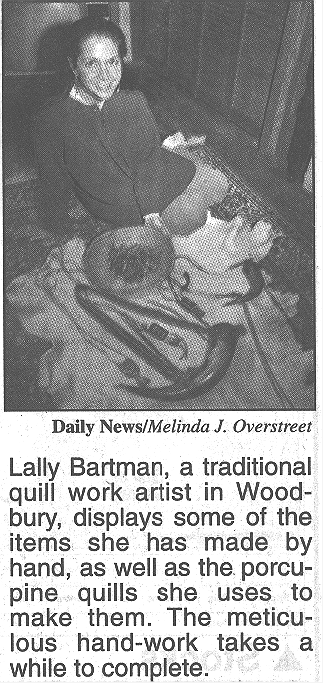| WOODBURY-- Not too many people can take porcupine quills and turn them into artwork, but Lally Bartman has been doing it for 24 years. All of her designs are derived from Eastern Woodlands Indians' traditional designs. Quills can be used in at least half a dozen traditional techniques. The most common involve embroidering the quills on top of leather, wrapping quills around rawhide or leather thongs, which are stringlike strips of leather, and weaving quills into linen thread on a loom and then embroidering it onto leather with linen thread. Bartman does her quillwork on only smoked, brain tanned leather from deer, elk or moose. She makes items as they are ordered and rarely has any extra items around her Butler County home. Art collectors have purchased some of her larger items, she says and she meets many of her customers at living history events, primitive rendezvous, and juried trade shows that she and her husband Frank House, a flintlock gunmaker, attend. "I'll quill any accouterment traditionally correct prior to 1790," Bartman says. Powder horn straps, leg ties, neck bags, knife sheaths, and hair ornaments are her most commonly made items. She has made about 10 hunting bags, but they take alot of thought for the design, and the quillwork itself is a very time consuming art form, she says. Quillwork was the primary method of adornment before beads became a dominant trade item in the early 1800's, Bartman says. "Once beadwork became predominant, they virtually quit quillwork because there was so much preliminary work to do for dyeing," she says. Most of her skills have been self taught by trial and error, visiting alot of museums, and doing alot of research, she says, "but I did learn one technique from an older lady when I was 17 years old. That's when I became interested in quillwork and traditional art forms." For the past nine years, quilling has been Bartman's sole source of income. "That we know of, there are about 10 who still do Eastern Woodlands quillwork. Of those, four that we know of make their sole living from it," she says. But she is the only person in the country that she knows of who still uses only natural dyes from plants, fruits and bugs: yellow root for a golden yellow color, blood root for orange, indigo plant for blue, sumac berries for tan, walnuts for brown, wild grapes for black, and cochineal insects for red. For green, she uses indigo with an overbath of yellow root. In the autumn, when berries are at their fullest potency, Bartman dyes enough quills to last her a year. One porcupine can yield more than a bushel basketful of quills of different sizes. Friends living in northern states find porcupines that have been killed on the roads, skin them and send her the hides with quills attached. Bartman plucks or shaves off the quills and cleans the animal fat off so they will take the natural dye better. After the quills are dyed they must be wet before she can work with them. |
 |
You can contact her by using the followiing:
Lally M. Bartman
108 North Church Street
Woodbury ,KY 42288-9999
(502)-526-2133